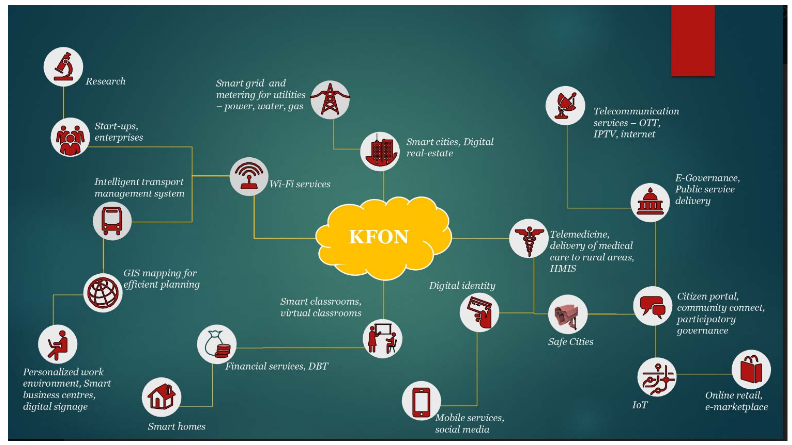Context:
Kerala has become the first state in the country to have its own internet service provider, Kerala Fibre Optic Network (KFON).
- In 2019, Kerala announced that Internet connection would be a basic right in the State.
| Probable Question:
Q. What are the key features and benefits of the Kerala Fibre Optic Network (KFON)? |

Image Credits: The Government of Kerala
About Kerala Fibre Optic Network:
- KFON is an optical fibre cable network of 30,000 kms, with 375 Points-of-Presence across Kerala.
- Aim: To create a core network infrastructure (information highway) with non-discriminatory access to all service providers, and to ensure a reliable, secure and scalable intranet connecting all government offices and educational institutions.
- Funding: The project is fully funded by Kerala Infrastructure Investment Fund Board (KIIFB).
- Licence: The Union Department of Telecommunications had provided Infrastructure Provider (category one) licence as well as the Internet Service Provider licence (category B) to the KFON.
- Internet Speed: KFON promises an internet speed from 10 mbps to 10 Gbps.
- Key Stakeholders of Project:
- The project implementation was taken up by a consortium led by Central PSU Bharat Electronics Limited.
- PriceWaterhouseCoopers is the consultant of the project.
- Major Services Provided:
- Connectivity to government offices
- Leasing of dark fibre
- Internet leased line
- Fibre to the home
- Wifi hotspots
- Colocation of assets under network operating centres and Point-of-Presences
- Internet protocol television
- OTT and cloud hosting
- Bharat Electronics (BEL) is the system integrator for the KFON project.
- The IP licence allowed the KFON to obtain fibre optic lines (dark fibre), towers, duct space, network and other related infrastructure facilities for establishing an optic fibre network.
Need of KFON:
- At Present, 80% of the towers are not fiberised in Kerala, an issue for the 4G to 5G transition.
- High-speed wireless connectivity (3G/4G) is limited in rural areas as more telecom towers need to be set-up to provide such services.
- Moreover, the majority of the existing towers are connected via radio, which limits the bandwidth that can be provided to the public.
- KFON is expected to solve this issue by connecting the nearly 8,000+ mobile towers in Kerala and significantly enhance the mobile call quality and accelerate the transition to 5G.
How will KFON operate?
- The network consists of 48 fibres. Out of which, KFON and KSEB will be using roughly half for their own operations.
- The rest will be leased out to generate money for funding the operational and upgrading costs.
- KFON to lease out unused fibres in Phase II.
- Once completed, the state will be divided into four regions and the operators will be selected via an open tender.
- These selectees will then be provided the required bandwidth at subsidized rates.
Benefits of KFON:
- Benefit to Service Providers: The KFON infrastructure will also benefit private service providers as they can use its cable network.
- Transition to 5-G: Once KFON is connected to mobile towers in Kerala, it will speed up transition to 4G and 5G.
- Affordability: It would also make Internet access more affordable as the State Government is effectively subsidising the infrastructure cost for ISPs and cable operators who can provide last mile Internet connectivity, and thus facilitating competition.
- Increased Speed: Further, the extensive fiber optic network is also expected to greatly improve the Internet speed, especially in rural areas.
- Social Perspective: A major highlight of the KFON is that the government wants to ensure internet connection for 20 lakh families below poverty line.
- Boost to e-Governance: It is also intended to give a fillip to e-governance and accelerate Kerala’s journey towards being a knowledge-based economy.
- Bridge the Digital Divide: K-FON will contribute substantially to reducing the digital divide and scale-up e-governance in the State.
Challenges to Digital Connectivity in India:
- Infrastructure Limitations: In rural and remote areas, there is inadequate infrastructure for internet connectivity.
- Affordability: The cost of internet services and digital devices can be prohibitive for many individuals and communities, particularly those with lower incomes.
- Geographical Barriers: Certain geographical factors, such as difficult terrain or remote locations, can make it challenging to establish connectivity infrastructure. Building and maintaining networks in such areas can be cost-prohibitive and technically challenging.
- Inclusive Access: Socioeconomic disparities and societal barriers may further limit their ability to access and utilise digital services.
- Digital Literacy: Limited understanding of digital platforms and services can prevent people from fully utilising the benefits of digital connectivity.
Way Forward:
- Infrastructure Development: Investment in laying fiber-optic cables, deploying wireless networks, and enhancing last-mile connectivity can help bridge the digital divide.
- Public-Private Partnerships: Public-private partnerships can help leverage resources, expertise, and innovative approaches to extend connectivity to underserved areas.
- Local Language Content: Facilitate the availability of digital content and services in regional languages to cater to linguistic diversity in India. Promote the development of localised applications, online resources, and government services in regional languages to make digital connectivity more inclusive.
| Additional Information:
About Digital Divide:
- The Digital Divide refers to the gap between individuals, communities, or countries that have access to and use information and communication technologies (ICTs) effectively and those that do not.
- It encompasses disparities in access to the internet, computer literacy, digital skills, and the ability to benefit from technology.
|
News Source: Livemint
![]() 12 Jun 2023
12 Jun 2023

